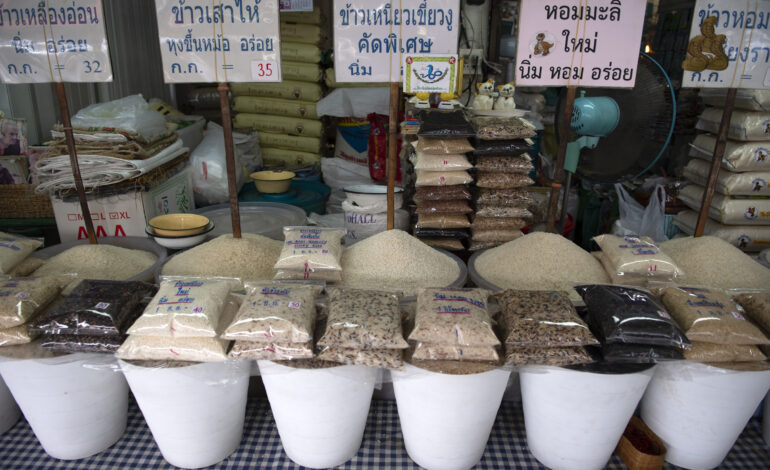
FAO’s benchmark index of food commodity prices in 2021 averaged sharply higher than in 2020
January 6, 2022 – Rome, Italy – World food prices fell slightly in December as international prices for vegetable oils and sugar fell significantly from lofty levels, the Food and Agriculture Organization of the United Nations reported today.
The FAO Food Price Index averaged 133.7 points in December, a 0.9 percent decline from November but still up 23.1 percent from December 2020. The index tracks monthly changes in the international prices of commonly-traded food commodities. Only the dairy sub-index posted a monthly rise in December.
For 2021 as a whole, averaging across the entire year, the FAO Food Price Index averaged 125.7 points, as much as 28.1 percent above the previous year.
“While normally high prices are expected to give way to increased production, the high cost of inputs, ongoing global pandemic and ever more uncertain climatic conditions leave little room for optimism about a return to more stable market conditions even in 2022, ” said FAO Senior Economist Abdolreza Abbassian.
The FAO Cereal Price Index decreased 0.6 percent from November, as falling wheat export quotations amid improved supplies following southern hemisphere harvests more than offset firmer maize prices underpinned by strong demand and concerns over persistent dryness in Brazil. For the full year, however, the FAO Cereal Price Index reached its highest annual level since 2012 and averaged 27.2 percent higher than in 2020, with maize up 44.1 percent, wheat up 31.3 percent, but rice down by 4.0 percent.
The FAO Vegetable Oil Price Index declined 3.3 percent in December, with weaker quotations for palm oil and sunflower oil reflecting subdued global import demand that may be linked to concerns over the impact of rising COVID-19 cases. For 2021 as a whole, the FAO Vegetable Oil Price Index reached an all-time high, increasing 65.8 percent from 2020.
The FAO Sugar Price Index decreased by 3.1 percent from November, reaching a five-month low, reflecting concerns over the possible impact of the Omicron COVID-19 variant on global demand as well as a weaker Brazilian Real and lower ethanol prices. For 2021 as a whole, the FAO Sugar Price Index rose 29.8 percent from the previous year to its highest level since 2016.
The FAO Meat Price Index was broadly stable in December but over 2021 as a whole, the FAO Meat Price Index was 12.7 percent higher than in 2020.
The FAO Dairy Price Index was the only sub-index to increase in December, rising 1.8 percent from the previous month, as international quotations for butter and milk powders increased amid lower milk production in Western Europe and Oceania. Cheese prices declined marginally, reflecting a preference for Western Europe dairy producers. In 2021, the FAO Dairy Price Index averaged 16.9 percent higher than in 2020.
Global food prices dip in December
FAO’s benchmark index of food commodity prices in 2021 averaged sharply higher than in 2020
January 6, 2022 – Rome, Italy – World food prices fell slightly in December as international prices for vegetable oils and sugar fell significantly from lofty levels, the Food and Agriculture Organization of the United Nations reported today.
The FAO Food Price Index averaged 133.7 points in December, a 0.9 percent decline from November but still up 23.1 percent from December 2020. The index tracks monthly changes in the international prices of commonly-traded food commodities. Only the dairy sub-index posted a monthly rise in December.
For 2021 as a whole, averaging across the entire year, the FAO Food Price Index averaged 125.7 points, as much as 28.1 percent above the previous year.
“While normally high prices are expected to give way to increased production, the high cost of inputs, ongoing global pandemic and ever more uncertain climatic conditions leave little room for optimism about a return to more stable market conditions even in 2022, ” said FAO Senior Economist Abdolreza Abbassian.
The FAO Cereal Price Index decreased 0.6 percent from November, as falling wheat export quotations amid improved supplies following southern hemisphere harvests more than offset firmer maize prices underpinned by strong demand and concerns over persistent dryness in Brazil. For the full year, however, the FAO Cereal Price Index reached its highest annual level since 2012 and averaged 27.2 percent higher than in 2020, with maize up 44.1 percent, wheat up 31.3 percent, but rice down by 4.0 percent.
The FAO Vegetable Oil Price Index declined 3.3 percent in December, with weaker quotations for palm oil and sunflower oil reflecting subdued global import demand that may be linked to concerns over the impact of rising COVID-19 cases. For 2021 as a whole, the FAO Vegetable Oil Price Index reached an all-time high, increasing 65.8 percent from 2020.
The FAO Sugar Price Index decreased by 3.1 percent from November, reaching a five-month low, reflecting concerns over the possible impact of the Omicron COVID-19 variant on global demand as well as a weaker Brazilian Real and lower ethanol prices. For 2021 as a whole, the FAO Sugar Price Index rose 29.8 percent from the previous year to its highest level since 2016.
The FAO Meat Price Index was broadly stable in December but over 2021 as a whole, the FAO Meat Price Index was 12.7 percent higher than in 2020.
The FAO Dairy Price Index was the only sub-index to increase in December, rising 1.8 percent from the previous month, as international quotations for butter and milk powders increased amid lower milk production in Western Europe and Oceania. Cheese prices declined marginally, reflecting a preference for Western Europe dairy producers. In 2021, the FAO Dairy Price Index averaged 16.9 percent higher than in 2020.





